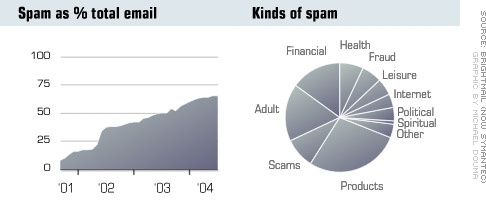What is "Spam"?
Introduction
Spam is junk email. While there are several generally compatible definitions of "spam," spam is defined by the Spam{{`Assassin project as Unsolicited Bulk Email (UBE). Email that is not spam is often called Ham. Another definition, Unsolicited Commercial Email (UCE) is not used by the Spam}}`Assassin project because some spam is clearly not commercial and some unsolicited mail which is not bulk is (often) actually wanted.
Spam really began to be a problem in 2002, and has been plaguing internet users ever since. The following graphs show the dramatic rise in spam, and typical spam topics. (Statistics vary from person to person, and from metric to metric, but these statistics from Brightmail, now Symantec, are fairly representative.)
The Origin Of The Name "Spam"
The term "spam" comes from the Monty Python sketch where the name of the canned meat product is used so often that it crowds everything else out. In the 1970s, British comedy troupe Monty Python did a sketch involving Spam. The diner menu, as recited by a waitress (Terry Jones in drag), consisted of "egg and bacon; egg sausage and bacon; egg and Spam; egg bacon and Spam; egg bacon sausage and Spam; Spam bacon sausage and Spam; Spam egg Spam Spam bacon and Spam; Spam sausage Spam Spam bacon Spam tomato and Spam; Spam Spam Spam egg and Spam; Spam Spam Spam Spam Spam Spam baked beans Spam Spam Spam; etc." All the while, Spam-loving Vikings in the background sing its praises.
The word SPAM is actually a registered trademark of Hormel Foods Corporation. Their trademark guidelines say:
We do not object to use of this slang term to describe UCE, although we do object to the use of the word "spam" as a trademark and to the use of our product image in association with that term.
Also, if the term is to be used, it should be used in all lower-case letters to distinguish it from our trademark SPAM, which should be used with all uppercase letters. We hope that Spam with an uppercase letter S (as in SpamAssassin) is ok, too
The first spams
The first UBE is quite old, with the earliest surviving example being sent 3 May 1978 by a marketer for DEC - Digital Equipment Corporation. Read more in an article about the first UBEs.
But prior to 1993, email was used mostly in academic circles, UBE minimally affected people, and the term was "spam" had nothing to do with email. Spam was mentioned occasionally in computer circles as a humorous name for a computer. See a detailed history of the word "spam" for UBE.
The term "spam" came into broad use shortly after a famous incident on 12 April 1994. Canter and Siegel unleashed the first mega-spam against Usenet. (Cantor had done local, mini-spams before; he was now going international.) Canter spammed almost 6,000 groups in less than 90 minutes through an Internet Direct account (an Arizona Internet provider). The post was a C&S ad for the U.S. "Green Card lottery" – a chance for non-Americans to enter a very low-odds US-work-permit raffle. Jeff Wheelhouse, sysadmin for Internet Direct, was soon bombed into oblivion by world-wide complaints. He told the New York Times this caused Internet Direct computers to crash at least 15 times – "that's when we stopped counting." Canter soon appeared on CNN's Sonya Live. Interestingly, spam was viewed as an innovation by Sonya, who hailed Canter as a Business Pioneer instead of Wanton Vandal. Canter boasted he'd spam again.
By May 1994, the term was entering common parlance, and is discussed in this 1994-05-19 and 1994-05-25 Usenet posting. Another early appearances of spam was and Taford's Investment Opportunities (to 200 newsgroups). Another early term was "mailbombing," which is bombarding someone's email inbox, but that is not a a common term today.
(Sources: Articles by Brad Templeton. Also see Computer Underground Digest, Wed Oct 12, 1994, Volume 6 : Issue 89, ISSN 1004-042X. See 1 Oct 1994 usenet posting by K.K.Campbell for more details, as well as the other above UseNet links.)
Related Links
- Wikipedia article (C) on Spam, spam and SPAM
- Wikipedia article about email spam.
